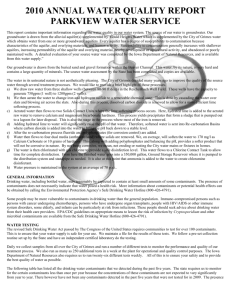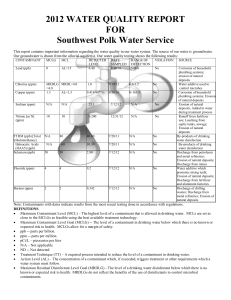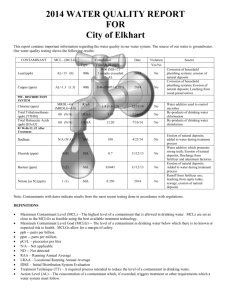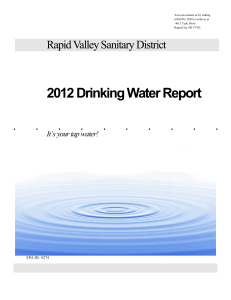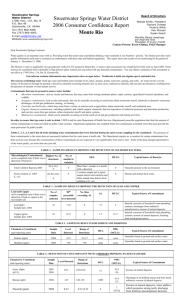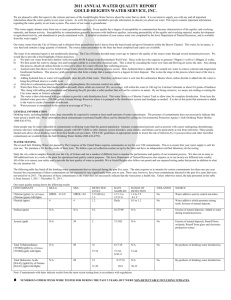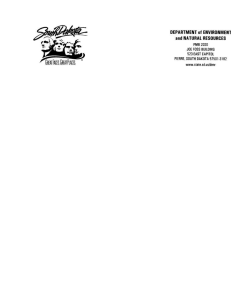2014 Consumer Confidence Report Water System Name: Western
advertisement
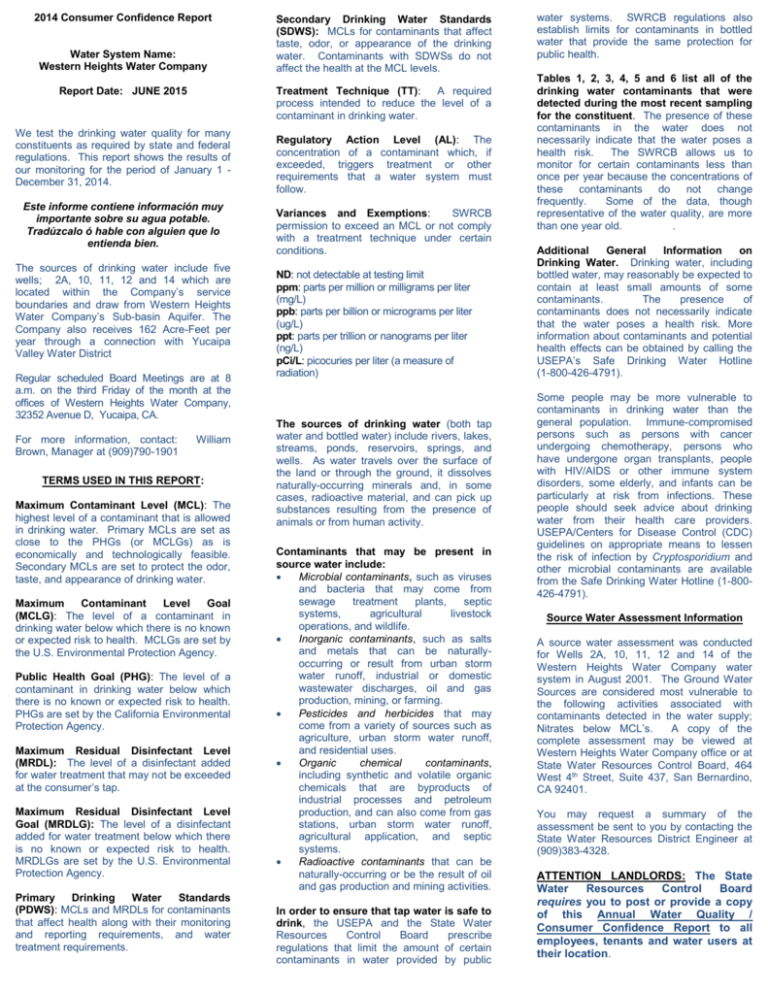
2014 Consumer Confidence Report Water System Name: Western Heights Water Company Report Date: JUNE 2015 Treatment Technique (TT): A required process intended to reduce the level of a contaminant in drinking water. We test the drinking water quality for many constituents as required by state and federal regulations. This report shows the results of our monitoring for the period of January 1 December 31, 2014. Este informe contiene información muy importante sobre su agua potable. Tradúzcalo ó hable con alguien que lo entienda bien. The sources of drinking water include five wells; 2A, 10, 11, 12 and 14 which are located within the Company’s service boundaries and draw from Western Heights Water Company’s Sub-basin Aquifer. The Company also receives 162 Acre-Feet per year through a connection with Yucaipa Valley Water District Regular scheduled Board Meetings are at 8 a.m. on the third Friday of the month at the offices of Western Heights Water Company, 32352 Avenue D, Yucaipa, CA. For more information, contact: Brown, Manager at (909)790-1901 Secondary Drinking Water Standards (SDWS): MCLs for contaminants that affect taste, odor, or appearance of the drinking water. Contaminants with SDWSs do not affect the health at the MCL levels. William TERMS USED IN THIS REPORT: Maximum Contaminant Level (MCL): The highest level of a contaminant that is allowed in drinking water. Primary MCLs are set as close to the PHGs (or MCLGs) as is economically and technologically feasible. Secondary MCLs are set to protect the odor, taste, and appearance of drinking water. Maximum Contaminant Level Goal (MCLG): The level of a contaminant in drinking water below which there is no known or expected risk to health. MCLGs are set by the U.S. Environmental Protection Agency. Public Health Goal (PHG): The level of a contaminant in drinking water below which there is no known or expected risk to health. PHGs are set by the California Environmental Protection Agency. Maximum Residual Disinfectant Level (MRDL): The level of a disinfectant added for water treatment that may not be exceeded at the consumer’s tap. Maximum Residual Disinfectant Level Goal (MRDLG): The level of a disinfectant added for water treatment below which there is no known or expected risk to health. MRDLGs are set by the U.S. Environmental Protection Agency. Primary Drinking Water Standards (PDWS): MCLs and MRDLs for contaminants that affect health along with their monitoring and reporting requirements, and water treatment requirements. Regulatory Action Level (AL): The concentration of a contaminant which, if exceeded, triggers treatment or other requirements that a water system must follow. Variances and Exemptions: SWRCB permission to exceed an MCL or not comply with a treatment technique under certain conditions. ND: not detectable at testing limit ppm: parts per million or milligrams per liter (mg/L) ppb: parts per billion or micrograms per liter (ug/L) ppt: parts per trillion or nanograms per liter (ng/L) pCi/L: picocuries per liter (a measure of radiation) The sources of drinking water (both tap water and bottled water) include rivers, lakes, streams, ponds, reservoirs, springs, and wells. As water travels over the surface of the land or through the ground, it dissolves naturally-occurring minerals and, in some cases, radioactive material, and can pick up substances resulting from the presence of animals or from human activity. Contaminants that may be present in source water include: Microbial contaminants, such as viruses and bacteria that may come from sewage treatment plants, septic systems, agricultural livestock operations, and wildlife. Inorganic contaminants, such as salts and metals that can be naturallyoccurring or result from urban storm water runoff, industrial or domestic wastewater discharges, oil and gas production, mining, or farming. Pesticides and herbicides that may come from a variety of sources such as agriculture, urban storm water runoff, and residential uses. Organic chemical contaminants, including synthetic and volatile organic chemicals that are byproducts of industrial processes and petroleum production, and can also come from gas stations, urban storm water runoff, agricultural application, and septic systems. Radioactive contaminants that can be naturally-occurring or be the result of oil and gas production and mining activities. In order to ensure that tap water is safe to drink, the USEPA and the State Water Resources Control Board prescribe regulations that limit the amount of certain contaminants in water provided by public water systems. SWRCB regulations also establish limits for contaminants in bottled water that provide the same protection for public health. Tables 1, 2, 3, 4, 5 and 6 list all of the drinking water contaminants that were detected during the most recent sampling for the constituent. The presence of these contaminants in the water does not necessarily indicate that the water poses a health risk. The SWRCB allows us to monitor for certain contaminants less than once per year because the concentrations of these contaminants do not change frequently. Some of the data, though representative of the water quality, are more than one year old. . Additional General Information on Drinking Water. Drinking water, including bottled water, may reasonably be expected to contain at least small amounts of some contaminants. The presence of contaminants does not necessarily indicate that the water poses a health risk. More information about contaminants and potential health effects can be obtained by calling the USEPA’s Safe Drinking Water Hotline (1-800-426-4791). Some people may be more vulnerable to contaminants in drinking water than the general population. Immune-compromised persons such as persons with cancer undergoing chemotherapy, persons who have undergone organ transplants, people with HIV/AIDS or other immune system disorders, some elderly, and infants can be particularly at risk from infections. These people should seek advice about drinking water from their health care providers. USEPA/Centers for Disease Control (CDC) guidelines on appropriate means to lessen the risk of infection by Cryptosporidium and other microbial contaminants are available from the Safe Drinking Water Hotline (1-800426-4791). Source Water Assessment Information A source water assessment was conducted for Wells 2A, 10, 11, 12 and 14 of the Western Heights Water Company water system in August 2001. The Ground Water Sources are considered most vulnerable to the following activities associated with contaminants detected in the water supply; Nitrates below MCL’s. A copy of the complete assessment may be viewed at Western Heights Water Company office or at State Water Resources Control Board, 464 West 4th Street, Suite 437, San Bernardino, CA 92401. You may request a summary of the assessment be sent to you by contacting the State Water Resources District Engineer at (909)383-4328. ATTENTION LANDLORDS: The State Water Resources Control Board requires you to post or provide a copy of this Annual Water Quality / Consumer Confidence Report to all employees, tenants and water users at their location. Microbiological Contaminants (to be completed only if there was a detection of bacteria) Total Coliform Bacteria Fecal Coliform or E. coli TABLE 1 – SAMPLING RESULTS SHOWING THE DETECTION OF CLORIFORM BACTERIA Highest No. of No. of months MCL MCLG Typical Source of Bacteria Detections in violation (in a mo.) 0 (in a year) 0 Lead and Copper (to be completed only if there was a detection of lead or copper in the last sample set) Lead (ppb) Copper (ppm) Chemical or Constituent (and reporting units) Sodium (ppm) Hardness (ppm) Calcium (ppm) Magnesium Chemical or Constituent (and reporting units) 1,1 Dichloroethylene(DCE) (ppb) 0 More than 1 sample in a month with a detection A routine sample and a repeat sample detect total coliform and either sample also detects fecal coliform or E. coli 0 0 Naturally present in the environment 0 Human and animal fecal waste TABLE 2 – SAMPLING RESULTS SHOWING THE DETECTION OF LEAD AND COPPER No. of Samples 90th percentile No. sites AL PHG Typical Source of Contaminant Collected level detected exceeding AL 20 ND 0 15 2 20 ND 0 1.3 0.17 Internal corrosion of household water plumbing systems; discharges from industrial manufacturers; erosion of natural deposits Internal corrosion of household plumbing systems; erosion of natural deposits; leaching wood preservatives TABLE 3 – SAMPLING RESULTS FOR SODIUM AND HARDNESS Level Detected Range of MCL PHG Typical Source of Contaminant Detections (MCLG) 05/13/13 27.83 21 – 73 NONE NONE Naturally occurring mineral found in ground and surface water 05/13/13 182 150 – 390 NONE NONE Naturally occurring mineral found in ground and surface water 05/13/13 55.63 49 – 96 NONE NONE Naturally occurring mineral found in ground and surface water 05/13/13 11.03 8.3 - 37 NONE NONE Naturally occurring mineral found in ground and surface water TABLE 4 – DETECTION OF CONTAMINANTS WITH A PRIMARY DRINKING WATER STANDARD Sample Date Level Detected Range of MCL PHG Typical Source of Contaminant Detections (MCLG) 06/16/14 0.001 ND - 1.0 6.0 10 Discharge from industrial chemical factories Sample Date Gross Alpha(ppb) 10/26/10 0.73 ND - 12 15 0 Erosion of natural deposits Arsenic(ppb) 05/13/13 0.21 ND – 8.9 10 0.0004 Erosion of natural deposits; residual from some surface water treatment processes Chlorine Residual RAA(ppb) 12/31/14 0.18 ND – 2.20 4 4 Fluoride (ppm) 05/13/13 0.53 0.47 – 1.1 2.0 1.0 Hexavalent Chromium(ppb) 10/07/14 4.3 ND – 8.2 10 .02 Nitrate as (NO3) (ppm) 05/05/14 16.56 6.2 – 34 45 45 A running annual average of drinking water disinfectant added for treatment Erosion of natural deposits; Water additive which promotes strong teeth Discharge from fertilizer and aluminum factories Discharge from electroplating factories, leather tanneries, wood preservation, chemical synthesis, refractory production, and textile manufacturing facilities; erosion of natural deposits Runoff from fertilizer use; Leaching from septic tanks, sewage; Erosion of natural deposits. Dibromochloropropane (DBCP)(ppb) 06/16/14 0.02 ND – 0.13 200 1.7 TTHMs (Total Trihalomethanes)(ppb) 08/11/14 9.83 ND – 47 80 N/A Banned nematocide that may still be present in soils due to runoff/leaching from former use on soybeans, cotton, vineyards, tomatoes, and tree fruit Byproduct of water disinfection Total Haloacetic Acids (HAA5)(ppb) 08/11/14 1.61 ND – 8.0 60 N/A Byproduct of water disinfection Uranium(pci/L) 12/31/14 0.26 ND – 5.9 20 0.43 Erosion of natural deposits Radium 228(pci/L) 12/31/14 0.008 ND – 0.49 5 0.019 Erosion of natural deposits Tetrachloroethylene (PCE) (ppb) 08/27/2013 0.091 ND - .55 5 0.06 Discharge from factories, dry cleaners, and auto shops (auto degreaser) Chemical or Constituent (and reporting units) Chloride(ppb) TABLE 5 – DETECTION OF CONTAMINANTS WITH A SECONDARY DRINKING WATER STANDARD Sample Date Level Detected Range of MCL PHG Typical Source of Contaminant Detections (MCLG) 05/13/13 17.85 10 – 88 500 None Runoff/leaching from natural deposits Color(ppb) 05/13/13 0.19 ND – 5 15 None Naturally occurring organic materials Iron(ppb) 05/13/13 0.001 ND – 110 300 None Leaching from natural deposits; industrial wastes Manganese(ppb) 05/13/13 0.88 ND – 23 50 None Leaching from natural deposits Odor(ppb) 06/10/13 1.02 1 – 1.15 3 None Naturally occurring organic materials Specific Conductance(ppb) 05/13/13 403.33 430 – 530 1600 None Sulfate(ppb) 05/13/13 37.38 31 – 66 500 None Substances that form icons when in water; seawater influence Runoff/leaching from natural deposits; industrial waste Total Dissolved Solids(ppb) 05/13/13 299.83 260 – 330 1000 None Runoff/leaching from natural deposits Total Hardness (ppm) 05/13/13 182 150 – 390 No standard None Turbidity(ppb) 05/07/13 0.04 ND – 1.1 5.0 None A typical indicator of the mineral content in the water supply Soil Runoff Oak Glen Surface Water Filtration Facility (Multi-Stage Media Filter) Percentage of Total Drinking Water Supply 1.91% Treated at Each Water Purification Turbidity Performance Standards (b)(that must Turbidity of filtered water must: be met through the water treatment process) 1. Be ≤ 0.3 NTU in 95% of measurements in a month. 2. Not to exceed 1 NTU for more than eight consecutive hours 3. Not exceed 1 NTU at any time Lowest monthly percentage of samples that met 100% Turbidity Performance Standard No. 1 Highest single turbidity measurement during the 0.065 NTU year Number of violations of any surface water Zero treatment requirements Yucaipa Valley Regional Water Filtration Facility (Microfiltration and Nanofiltration) 22.94% Turbidity of filtered water must: 1. Be ≤ 0.1 NTU on 95% of measurements in a month. 2. Not exceed 1 NTU for more than eight consecutive hours 3. Not exceed 1 NTU at any time. 100% 0.055 NTU Zero

